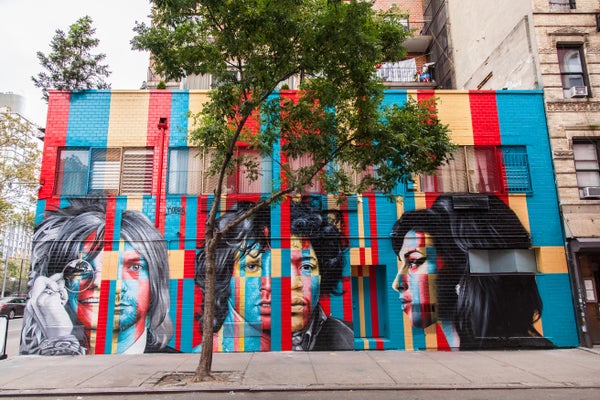
WWW.SCIENTIFICAMERICAN.COM
The Myth that Musicians Die at 27 Shows How Superstitions Are Made
November 4, 20244 min readThe Myth that Musicians Die at 27 Shows How Superstitions Are MadeFamous people who die at 27, such as Janis Joplin, Jimi Hendrix and Amy Winehouse, get even more famous because of the mythology surrounding that numbera look at how modern folklore emergesBy Rachel Nuwer"Club 27" mural by Eduardo Kobra, 170 Forsyth Street & Rivington Street on New York City's Lower East Side. Edward Westmacott/Alamy Stock Photo.Zackary Dunivin, a sociologist now at the University of California, Davis, was watching a movie about artist Jean-Michel Basquiat when something in the epilogue caught his attention. Basquiat, the explanatory text stated, died of a drug overdose at the age of 27. Dunivin felt that something about this particular age seemed to lend additional weight to the tragedy of Basquiats death, and he quickly realized why: Basquiat was a member of the 27 Club. This widespread myth holds that famous people, especially musicians, are unusually likely to die at age 27.The film, Basquiat, made Dunivin wonder about how the 27 Club myth propagates itself and what that means for the people who are caught up in it. In a new Proceedings of the National Academy of Sciences USA paper, he provides some answers: more attention is paid to people who die at the age of 27 because of the existence of the club, he found, and this creates a positive feedback loop that both strengthens the legends potency and the fame of those it pertains to.The weird thing about this particular myth is: even if you dont know about the 27 Club, you encounter more famous dead people who died at 27, Dunivin says. Weve made this myth appear to be true because the appearance that more people who die at 27 is real.On supporting science journalismIf you're enjoying this article, consider supporting our award-winning journalism by subscribing. By purchasing a subscription you are helping to ensure the future of impactful stories about the discoveries and ideas shaping our world today.The idea that especially talented people are prone to untimely deaths goes back to ancients. As noted by the Greek playwright Menander in the Fourth Century B.C.E., Whom the gods love die young.The idea that musicians, artists, actors and other creative people are more likely to die specifically at the age of 27, however, emerged more recently, after a series of high-profile deaths in the early 1970s. Between 1969 and 1971, Brian Jones, Jimi Hendrix, Janis Joplin and Jim Morrison each died at that age. By chance, these rock stars were all icons of the counterculture movement, and the first and last of their deaths occurred two years apart to the day. We are meaning-making machinesthats what we do as human beings, Dunivin says. You look at that and say, It cant be a coincidence!The fact that people latched on to this particular group of deaths in the 1970s is somewhat justified, Dunivin continues, because of just how unusual it was. In the new paper, he calculated a steep one in 100,000 chance that four 27-year-olds at the top of a Wikipedia list of famous peoplethe lists 99.9th percentile, true superstars, as Dunivin sayswould die in a two-year period.The myths popularity has been revived and reinforced over the years, he adds, by other headline-making deaths of famous 27-year-olds, including Kurt Cobain and Amy Winehouse.Dunivin did not set out to debunk the myth itselfthat had already been done by another group of researchers in 2011. Instead he wanted to untangle how a legend that emerged out of a random but truly strange series of events went on to have a real-world impact by shaping the legacies of other famous people who subsequently died at 27.For the data, Dunivin and his co-author, sociologist Patrick Kaminski of Indiana University Bloomington and the University of Stuttgart in Germany, turned to a database of notable people that includes nearly everyone with a Wikipedia page in all languages. They limited their analysis to people who were born after 1900 and who died before 2015, leaving them with 344,156 individuals. The researchers used page visits as a proxy for fame.Statistical models that they used reconfirmed that there is no increased risk of famous people dying at age 27. Among those in the 90th percentile of fame and higher, however, those who died at 27 did experience an extra boost in popularity that could not be accounted for by other factors. The effect was particularly pronounced for the most famous of the famous, or individuals who roughly achieved the 99th percentile of fame. That bump indicates that people who die at age 27 are considerably more likely to be more famous than those who die at 26 or 28, Dunivin says.Cultural myths are generally very hard to study empirically, says Omar Lizardo, a sociologist at the University of California, Los Angeles, who was not involved in the work. But by using a clever approach, he says, Dunivin and Kaminski did a good job of providing a lot of circumstantial evidence that the phenomenon is real and that artists who die around that age garner more attention and notoriety.Timothy Tangherlini, a folklorist at the University of California, Berkeley, who was not involved in the research, calls it a major contribution to what is known as computational folklore.The authors succeed in leveraging sophisticated statistical models and novel data to understand the feedback mechanisms of belief, storytelling and their real-world effects, Tangherlini says. Ultimately, they provide a mechanism for understanding how, in death, these young musiciansbecause of an unusual coincidence of timinghave grown in fame because of the emergence of a coordinating narrative that clearly resonated among fans and the broader public.
0 Σχόλια
0 Μοιράστηκε
12 Views


